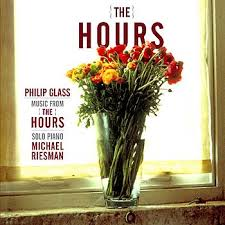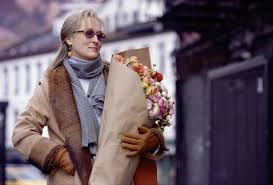Posted by Sarah
Rosa has very kindly summarised our recent discussion on The Hours (2002):
The topics that were discussed after the screening were the essential ones mentioned in the previous introduction: music, costume, narrative and performance in (domestic) melodrama.
 The original soundtrack, composed by Philip Glass, shows the importance of music, both in this film and in melodrama in general, as an element that supports the narrative as well as being powerful enough to stand out independently. Stephen Daldry, the director, talked about it at length in an interview (DVD extras) and highlighted how the repetition of the same theme over and over again makes the tension stronger in important points of the movie and helps bringing together all three stories, by mainly using the same piano theme.
The original soundtrack, composed by Philip Glass, shows the importance of music, both in this film and in melodrama in general, as an element that supports the narrative as well as being powerful enough to stand out independently. Stephen Daldry, the director, talked about it at length in an interview (DVD extras) and highlighted how the repetition of the same theme over and over again makes the tension stronger in important points of the movie and helps bringing together all three stories, by mainly using the same piano theme.
 In melodrama, costume and décor are crucial, and this film is an extraordinary example of a magnificent use of such resources. It is impossible not to link the initial sentence of the book Mrs. Dalloway, “Mrs.Dalloway said she would buy the flowers herself”, with the multiple patterns, prints and real flowers that from the very beginning of the film flood the screen. They are in the outfits, accessories, robes and dressing gowns of the female protagonists, the ties of the male characters, the wall paper- mainly in the 50s section of the film, there are fresh flowers in every household, a flower shop and a few scenes shot on location in Richmond’s gardens and parks. Katerina pointed out the dual meaning of flowers, which is quite applicable in this film: the ephemeral quality of them is an allegory of life/love, main themes of the story.
In melodrama, costume and décor are crucial, and this film is an extraordinary example of a magnificent use of such resources. It is impossible not to link the initial sentence of the book Mrs. Dalloway, “Mrs.Dalloway said she would buy the flowers herself”, with the multiple patterns, prints and real flowers that from the very beginning of the film flood the screen. They are in the outfits, accessories, robes and dressing gowns of the female protagonists, the ties of the male characters, the wall paper- mainly in the 50s section of the film, there are fresh flowers in every household, a flower shop and a few scenes shot on location in Richmond’s gardens and parks. Katerina pointed out the dual meaning of flowers, which is quite applicable in this film: the ephemeral quality of them is an allegory of life/love, main themes of the story.
In the  same way as characters are connected by music, flowers and scenography, colours and prints in the outfits give away messages that we are able to read and understand as the film goes by, bringing all characters together once more. There is a hidden and less obvious case, very cleverly placed within the storyline: Richard (Ed Harris) wears a blue robe with some kind of solar system pattern which happens to be the same fabric as the covers in little Richie’s bed back in the 1950s. If you are able to uncover the meaning of this double use of the same material, you will then be able to predict the end before the film finishes. Jane Gaines (“Costume and Narrative: how dress tells the woman’s story.” Fabrications: costume and the female body (1990): 180-211.) asserts that the costume should not anticipate the narrative plot, but on this occasion dialogue and wardrobe do give us hints of what will happen in the scenes to follow. Clarissa Vaughan says she has a premonition and in the next seen we see her wearing black, which we then learn was an anticipation of the death by suicide of her friend and ex-lover Richard. She wears an orange scarf over her total-black outfit, which could be a visual recourse in order to add definition to the silhouette or, reading more into the symbolism in this film, could express change or mutation, a generally accepted meaning of the colour orange.
same way as characters are connected by music, flowers and scenography, colours and prints in the outfits give away messages that we are able to read and understand as the film goes by, bringing all characters together once more. There is a hidden and less obvious case, very cleverly placed within the storyline: Richard (Ed Harris) wears a blue robe with some kind of solar system pattern which happens to be the same fabric as the covers in little Richie’s bed back in the 1950s. If you are able to uncover the meaning of this double use of the same material, you will then be able to predict the end before the film finishes. Jane Gaines (“Costume and Narrative: how dress tells the woman’s story.” Fabrications: costume and the female body (1990): 180-211.) asserts that the costume should not anticipate the narrative plot, but on this occasion dialogue and wardrobe do give us hints of what will happen in the scenes to follow. Clarissa Vaughan says she has a premonition and in the next seen we see her wearing black, which we then learn was an anticipation of the death by suicide of her friend and ex-lover Richard. She wears an orange scarf over her total-black outfit, which could be a visual recourse in order to add definition to the silhouette or, reading more into the symbolism in this film, could express change or mutation, a generally accepted meaning of the colour orange.
Ann-Marie pointed out that it would have not been necessary to indicate in which period and place each story takes place, as the set and costumes are so significant, different and remarkable of each of the three stories, we are perfectly able to identify them. We compared it with how the book is organized and how in a written piece, it is necessary to specify more. In classical melodrama, as mentioned above, costume plays a very important role and this film is able to take us back to the original concept because of its richness in meaning and very intelligent use of the wardrobe. The contemporary part of the film is supported by the other two and all of them work together in a great way.
Thank you all very much for your participation and your very interesting comments!
And many thanks to Rosa for choosing such a rich film for us all to enjoy.
Do, as ever, log in comment or email me on sp458@kent.ac.uk to add your thoughts.





